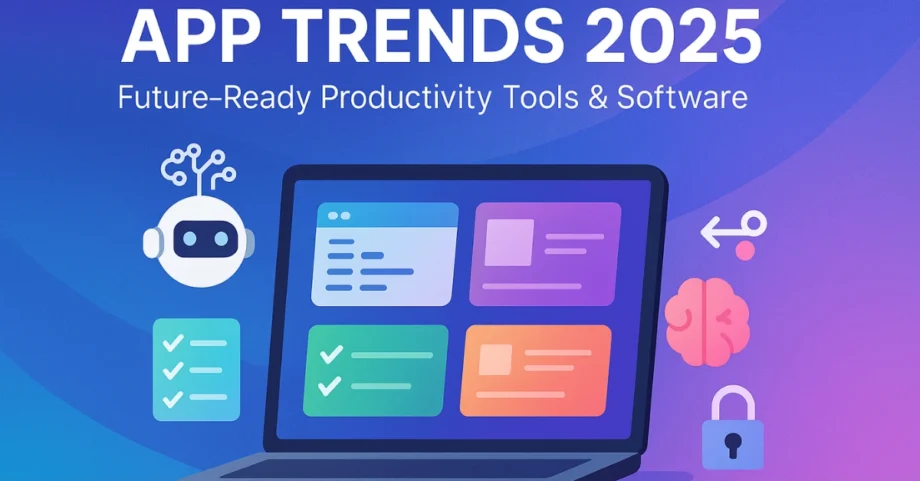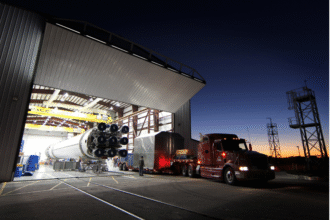In 2025, productivity isn't just about getting things done—it’s about how smartly, securely, and collaboratively we do it. With work becoming more distributed, tech-first, and automated than ever before, app trends are now central to shaping how professionals, teams, and startups operate. The workplace of today is no longer confined to physical offices or 9-to-5 schedules—it lives across time zones, devices, and digital platforms.
App trends in 2025 highlight a massive shift toward AI-powered assistants, unified workspaces, automation-driven tools, and software that prioritizes deep work and clarity over chaos. From solopreneurs to agile remote teams and global enterprises, the modern workforce is increasingly turning to purpose-built solutions to boost efficiency and minimize cognitive overload.
Ask ChatGPT
As we head deeper into 2025, several pivotal app trends are emerging that redefine productivity—from smarter scheduling to async-first communication, and from ultra-secure platforms to minimalist interfaces. This guide explores the seven major productivity app trends dominating this year and what they mean for the future of work.
Let’s dive into the future of productivity and the tools that are making it possible.
1. The Rise of AI-Powered Productivity in 2025 App Trends
One of the most significant app trends defining 2025 is the rise of AI-powered productivity tools that don’t just assist—they think, plan, and act alongside you.
Tools like Notion AI, Jasper, Copy.ai, ChatGPT, and Google Workspace’s new AI integrations are taking over time-consuming tasks that used to demand manual input. From auto-generating blog drafts and marketing copy to suggesting next steps during a meeting, AI is becoming the beating heart of modern productivity software.
Let’s break down what this looks like in real-world workflows:
- Meeting summaries in seconds: No more endless notetaking—tools like Otter.ai and Notion AI now transcribe and summarize key points, saving hours of follow-up.
- Smart scheduling: AI tools like Motion and Clockwise analyze calendar conflicts and team availability to auto-schedule meetings that respect focus time.
- Content co-creation: Jasper and Copy.ai can create outlines, captions, landing pages, and email campaigns in minutes.
- Real-time writing assistance: Google Docs and Grammarly now offer AI-driven suggestions that improve tone, clarity, and structure in real time.
- Data-to-report transformation: AI platforms convert raw analytics into polished presentations, ideal for marketers, analysts, and sales teams.
These AI features are no longer niche. They are foundational across most app trends being adopted by solopreneurs, enterprise teams, and remote freelancers alike. In fact, what once required multiple platforms can now be accomplished within a single AI-augmented workspace.
AI copilots are especially popular among content creators, marketers, knowledge workers, and startup founders who seek faster results without compromising quality. By automating repetitive cognitive work, AI is unlocking more time for strategy, creativity, and deep thinking.
The future of app trends is crystal clear—AI is no longer an upgrade; it’s a baseline requirement. Whether you're brainstorming campaigns, planning projects, or analyzing reports, AI-infused tools are driving a seismic shift toward intelligent, context-aware productivity.
2. Seamless Integrations & Unified Work Hubs
Remember the days when switching tabs 30 times a day was the norm? In 2025, those days are over—or at least, they’re being challenged.
One of the strongest app trends of the year is the move toward all-in-one workspaces with seamless integrations. Today’s productivity platforms are aiming to be your entire stack—or at least integrate beautifully with the rest of it.
Examples include:
- Slack integrating directly with Google Meet and Notion
- Linear syncing tasks and PRs from GitHub
- Figma linking with design documentation in Notion
These unified hubs embrace the “single source of truth” philosophy—where project tasks, conversations, files, and decisions live in one accessible place.
No more app overload. No more information silos. Instead, future trends in productivity software are leaning heavily on APIs, low-code automation platforms like Zapier and Make, and native connectors that eliminate workflow friction.
If your team still hops between five tools to get one task done, it’s time to upgrade.
3. Async-First and Remote-Optimized Workflows
Distributed teams are now the default, not the exception—and app trends in 2025 reflect that reality more than ever.
Tools like Loom, Twist, Notion, and Threads are designed with asynchronous work in mind, allowing teams across time zones to collaborate without the constant pressure of being “live.”
What async-first tools enable:
- Video messages instead of meetings
- Threaded conversations over real-time chat
- Automated status updates
- Flexible schedules for deep focus time
As remote work evolves, so do expectations. The new standard? Flexibility, mobile-first design, and accessibility from anywhere. Most leading productivity platforms now offer offline access, mobile parity, and timezone intelligence, ensuring you’re never left behind—even on the go.
These changes aren’t just convenient—they’re foundational to how work is done in a hybrid or fully remote environment.
4. Focus on Mental Clarity and Minimalism
Less is more in 2025.
Amid the explosion of features, notifications, and endless task lists, there’s a countertrend growing: calm productivity. Users are gravitating toward tools with minimalist interfaces, fewer distractions, and design elements that promote mental clarity.
Rising minimalist apps include:
- Reflect – for distraction-free note-taking
- Superlist – a lightweight task manager focused on elegance
- Kinopio – for visual brainstorming without clutter
- Sunsama and Motion – daily planners that combine focus blocks with task scheduling
These tools help users prioritize deep work, manage mental bandwidth, and avoid the trap of productivity paralysis. It’s not about doing more—it’s about doing what matters most, better.
App trends in this category emphasize emotional wellness, digital well-being, and frictionless UX—marking a meaningful shift in the industry.
5. Vertical SaaS and Niche Productivity Apps
Gone are the days of one-size-fits-all software.
One of the standout app trends this year is the rise of vertical SaaS—productivity platforms built specifically for distinct industries and roles. Think tools tailored for marketers, engineers, product managers, or recruiters.
Popular vertical tools include:
- ClickUp for agencies
- Linear for engineering teams
- Miro for creative collaboration
- Tability for goal tracking
- Whimsical for product design
For small to mid-sized businesses, this trend is especially game-changing. The right SMB tools can supercharge operations, streamline customer communication, and reduce overhead.
For a detailed breakdown of the best tools for small teams, check out our guide:
23 Productivity Tools Every Small Business Needs
Vertical SaaS helps you avoid the bloat of general-purpose platforms—and gets you exactly what your team needs to thrive.
6. Security and Privacy-Focused Apps
In a world where data breaches and surveillance are growing concerns, 2025’s app trends include a strong focus on privacy-first productivity.
Tools like:
- Proton Mail & Proton Drive – encrypted communication and storage
- Skiff – decentralized document editing
- Obsidian – local-first note-taking with zero cloud dependency
These apps put users in control of their data, a move that aligns with rising global regulations (like GDPR and India's DPDP Act). For professionals and teams handling sensitive projects, data control is now non-negotiable.
This shift answers the informational query: What trends in productivity? Security and privacy are no longer features—they’re core product values.
Expect more tools in this space to offer zero-knowledge encryption, local sync options, and transparent data policies going forward.
7. Community-Built and Open Source Tools
The final trend shaping the future? Decentralized and open platforms.
We’re witnessing a resurgence of open source and community-owned tools that offer transparency, customizability, and independence from Big Tech ecosystems.
Rising stars include:
- Logseq – a privacy-first, open source alternative to Notion
- Anytype – a decentralized workspace that works offline
- Outline – team knowledge base software you can self-host
These tools are gaining traction among developers, privacy-conscious users, and indie teams seeking control over their workflows.
This app trend speaks to a broader demand: people want tools they can trust—and tools that won’t be discontinued or monetized overnight. The community model adds resilience, innovation, and long-term sustainability.
Conclusion: What’s Next in Productivity?
The productivity landscape in 2025 is driven by innovation, intelligence, and user-centered design. As app trends continue to evolve, they’re reshaping how individuals and teams approach work—making it more efficient, flexible, and intuitive.
From AI copilots transforming workflows to vertical tools crafted for specific roles, and from async-first collaboration to open-source, privacy-focused platforms—today’s app trends are building the foundation for a smarter, more sustainable way of working.
To recap, here are the future trends in productivity software leading the way:
- AI-powered automation and intelligent assistants
- Unified work hubs with seamless integrations
- Async-first workflows built for remote and hybrid teams
- Minimalist, focus-enhancing productivity apps
- Vertical SaaS tailored to industries and roles
- Security-driven platforms with data privacy at the core
- Open-source, community-led ecosystems
Looking ahead, the next breakthrough in productivity could be context-aware tools—platforms that understand your goals, mental bandwidth, and work style in real time.
To stay ahead of these evolving app trends, follow leading sources like SaaStr’s outlook on the future of work and subscribe to trusted productivity newsletters tracking the newest innovations.
In 2025 and beyond, success isn’t just about adopting productivity tools—it’s about choosing the right ones that align with the future trends in productivity software and empower you to work smarter, not harder.









